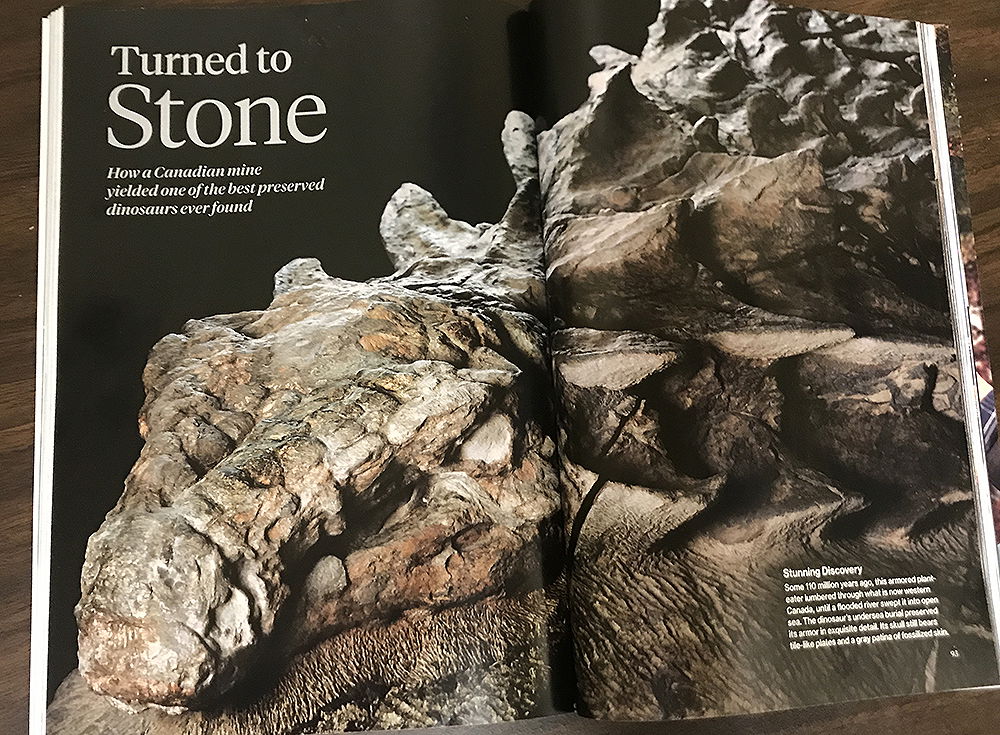
An Astonishingly Well-Preserved Dinosaur: Evidence for the Flood?
Many of our supporters have been asking about a recent article by National Geographic magazine. This article features breathtaking photos of a fossil of an incredibly life-like armored dinosaur (called a nodosaur). The photos are absolutely beautiful—the nodosaur looks as if it were a statue or frozen in time. What process or event could preserve a creature that well? (Hint: the Bible gives us the answer!)

Interestingly, this find was accidental. Miners in Alberta, Canada, uncovered the dinosaur and, thankfully, reported it so it could be saved for research and display. This fossil is so well preserved that researchers believe they know the creature’s original coloring—reddish with the horns featuring a light coloration—from preserved pigments.
Osteoderms, bony plates that make up the armor, are usually scattered when a fossil is recovered, but this fossil has the osteoderms preserved in place with “traces of the scales in between.” Sheaths of keratin “still coat many of the osteoderms, letting paleontologists see precisely how these sheaths exaggerated the armor’s size and shape.”
One expert said this specimen was so well preserved it “might have been walking around a couple of weeks ago. . . . I’ve never seen anything like this.” But how did it get to be so remarkably well preserved? According to the National Geographic article, 110 million years ago something like this happened:
One unlucky day this landlubbing animal ended up dead in a river, possibly swept in by a flood. The belly-up carcass wended its way downriver—kept afloat by gases that bacteria belched into its body cavity—and eventually washed out into the seaway. . . . Winds blew the carcass eastward, and after a week or so afloat, the bloated carcass burst. The body sank back-first onto the ocean floor, kicking up soupy mud that engulfed it. Minerals infiltrated the skin and armor and cradled its back, ensuring that the dead nodosaur would keep its true-to-life form as eons’ worth of rock piled atop it.
Is this rather unbelievable story really the best way to understand this find? Well, when we turn to God’s Word—which records the true history of the universe—we see a much more plausible explanation. As the floodwaters of the global Flood of Noah’s day (just 4,350 years ago) rose, organisms were rapidly buried in sediment layers. This dinosaur didn’t have to wash down a river into an ocean—it was overwhelmed by floodwaters and rapidly buried, cutting it off from scavengers, oxygen, and microbes before they had a chance to decompose the creature.
The Flood of Noah’s day provides the perfect framework for understanding remarkable fossils like this nodosaur.
The Flood of Noah’s day provides the perfect framework for understanding remarkable fossils like this nodosaur. When we start with the Bible’s history, what we see in the world makes sense.
We discussed this find in a recent episode of Answers News. Tune in at 2:30 p.m. ET every Monday and Thursday on my Facebook page to join us for that insightful program.
Thanks for stopping by and thanks for praying,
Ken
This item was written with the assistance of AiG’s research team.
Most Recent News
-
Dec. 29, 2025 from Ken Ham Blog
Vogue magazine recently published an article asking, “Is having a boyfriend embarrassing now?”—a question the author answers with a yes!
-
Dec. 23, 2025 from Ken Ham Blog
A recent news item caught my eye when I saw the headline: “18,000 dinosaur tracks discovered along ancient Bolivian coastline.”

Answers in Genesis is an apologetics ministry, dedicated to helping Christians defend their faith and proclaim the good news of Jesus Christ.
- Customer Service 800.778.3390
- Available Monday–Friday | 9 AM–5 PM ET
- © 2026 Answers in Genesis


